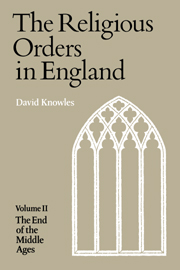Book contents
- Frontmatter
- Contents
- Preface
- List of Abbreviations
- Part One The Historical Framework
- Chap. I The opening of the period
- Chap. II Monks and canons at the university, 130c–1450
- Chap. III Patrons and architects: Ely and Gloucester
- Chap. IV Portraits of monks
- Chap. V Monks and friars in controversy
- Chap. VI Trends in speculation: Ockhamism, justification and grace
- Chap. VII Criticism of the religious in the fourteenth century
- Chap. VIII The spiritual life of the fourteenth century
- Chap. IX Developments within the orders: I
- Chap. X Developments within the orders: II
- Chap. XI The fortunes of the Cluniac houses and the alien priories
- Chap. XII The loosening of discipline
- Chap. XIII King Henry V
- Chap. XIV More portraits of monks
- Chap. XV The second century of visitation, 1350–1450
- Chap. XVI The spiritual life of the fifteenth century
- Part Two The Institutional Background
- Appendix I Chaucer's monk
- Appendix II Henry V and the Westminster recluse
- Appendix III Regulars as bishops
- Bibliography
- Index
Chap. VIII - The spiritual life of the fourteenth century
Published online by Cambridge University Press: 28 January 2010
- Frontmatter
- Contents
- Preface
- List of Abbreviations
- Part One The Historical Framework
- Chap. I The opening of the period
- Chap. II Monks and canons at the university, 130c–1450
- Chap. III Patrons and architects: Ely and Gloucester
- Chap. IV Portraits of monks
- Chap. V Monks and friars in controversy
- Chap. VI Trends in speculation: Ockhamism, justification and grace
- Chap. VII Criticism of the religious in the fourteenth century
- Chap. VIII The spiritual life of the fourteenth century
- Chap. IX Developments within the orders: I
- Chap. X Developments within the orders: II
- Chap. XI The fortunes of the Cluniac houses and the alien priories
- Chap. XII The loosening of discipline
- Chap. XIII King Henry V
- Chap. XIV More portraits of monks
- Chap. XV The second century of visitation, 1350–1450
- Chap. XVI The spiritual life of the fifteenth century
- Part Two The Institutional Background
- Appendix I Chaucer's monk
- Appendix II Henry V and the Westminster recluse
- Appendix III Regulars as bishops
- Bibliography
- Index
Summary
The calamities and controversies of the times, the crisis of the Roman Church and the symptoms of decline in the external life of the religious orders, real though they are and arresting to the mind, must not be allowed wholly to obscure the glimpses of an inner life caught here and there in the fourteenth century, the more particularly as the outward manifestations of this life are of a different character from what had gone before.
The outstanding examples of sanctity in the twelfth century were for the most part found among the founders of religious orders and eminent abbots and monk-bishops; the secular prelates, such as St Thomas of Canterbury and St William of York, who received formal recognition, owed it to a violent death. In the thirteenth century, by contrast, the type of sanctity is to be found most frequently in the zealous diocesan bishop who had previously been a master in the schools. The three Englishmen to achieve canonization, Edmund of Canterbury, Richard of Chichester and Thomas of Hereford, were all of this class, as were several others, such as Grosseteste of Lincoln, William Button of Bath and Wells, Roger Niger of London and Walter Cantilupe of Worcester, who left behind them a reputation for sanctity. The last of this generation were perhaps Winchelsey of Canterbury and Dalderby of Lincoln, for whose canonization repeated efforts were made. The episcopate of the fourteenth century was in general of a somewhat different type, drawn more largely from clerics who had previously served the king in an administrative or diplomatic capacity.
- Type
- Chapter
- Information
- Religious Orders Vol 2 , pp. 115 - 124Publisher: Cambridge University PressPrint publication year: 1979



